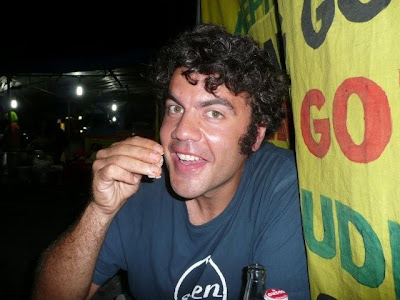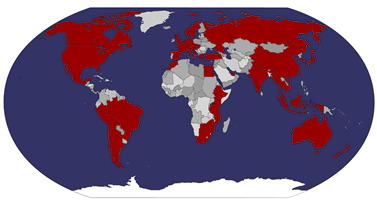
308km and only 5 hours! A miracle!

Train rolls in to the platform
The train arrives. Interestingly with the arrival of every train, boys sprint along and leap through the open doors of the carriages to earn money by portering. One boy per carriage, and they’re all on well before the train slows much. The numbering is slightly strange for the carriages, but I locate my allocated seat eventually, and find myself sitting next to the smiley and lovely Sinta, who is also heading to Jogja for the weekend. We agree to hang out. Yay, finally a local friend in Java!
On arrival in Jogja, or Yogyakarta, she uses a wartel (a call centre) to phone about, but almost every hotel is fully booked! Nightmare. We find rooms eventually at Bladok’s, an LP-recommended mid-range place which is actually very nice, though given the lack of rooms I reluctantly have to take a VIP room by the pool. Discounted thanks to Sinta. We go meet her DJ friend Adip –we’ll meet him again the following night at one of the clubs that he is MCing at.
Short walk into town (okay by town I mean the nearest shopping centre, as is the way in Indonesia, on Marliaboro Street, named after the Duke of Marlborough), Sinta goes to have something done to her hair, and I buy some books at Periplus, the expensive but *all English-language* book chain, thank the lord! So happy, I plonk myself in café Excelso (the local Starbucks clone) and devour Jerome K Jerome's Three Men on a Bummel. What a marvellous book! After, we head out to the burbs, Sinta wants to buy a laptop. The place she’s found is not dissimilar to Q’s house in the 2nd year – basically a bunch of students, laptops and general clutter! I recommended not purchasing.
Overall I have to say that I find Yogyakarta is a much more pleasant place to be than Surabaya. It is actually feasible to walk around, which one cannot say for the other major Javan cities I've encountered.
In the evening, I have my first experience of eating with my hands, which is the way most Indonesians and Malaysian Malays eat. If I had antibacterial hand wash in copious quantities, this would have been fine, but as it was.. Well I survived to write this blog anyway! The local dish is a heavily fried chicken wing on rice. Rice is okay to eat with hands when it’s dry and sticky, but as soon as some of the curry sauce gets on it, the challenge is upped somewhat. The theory behind eating with one’s hands is that the flavour is improved by contact with the body in advance of eating, and somehow the brain makes decisions about what sort of digestive juices to have waiting for the food. I switch to a spoon when the going gets too tough and don’t notice the difference.

Right hand.. good!


Spicy
Next we went to a puppet show, one of the must-do activities in cultural Jogja.

The show from the front
It’s called Wayang Kulit, shadow puppets and involves a chap sitting in front of a large screen with dozens of intricate leather puppets, which he holds up to tell the traditional stories, most of which come from India (spreading at the same time as Hinduism), accompanied by the Gamelan orchestra, which in Java is more sedate and tuneful.
Initially we watched from the front, but the experience is more interesting from behind, seeing the shadows of the puppets through the screen. We found a German couple round there on their own, boyfriend fast asleep.

And from behind

There are lots of characters to keep track of, though some of the people running the place wander round and occasionally explain what is happening.

Next day after a breakfast at Excelso café, our regular haunt by now, we head down to the Kraton, the Sultan’s Palace at the heart of Jogja. There is an enormous amount of symbolism in the design, but to be honest I found it to be run down and somewhat disappointing.

Cool open spaces

Detail

Ornate roofs in disrepair
They have a museum which includes many of the gifts presented to the Sultan from other countries. There is some real tat there – imagine all the most garish crystal and ornamental rubbish one would accumulate over many years. I’m sure our own Queen has this issue too – wasn’t Prince Philip once presented with a cow or buffalo by a tribe? Anyway, the museum also covers the 9th Sultan’s tenure – it would seem he is highly respected by the people, working hard to modernise Indonesia and to use his position for charity and good. Wonder how the 10th is getting on…

The Sultan’s family tree. Note boys are fruit, girls are leaves

Carriages, she loves 'em

Bandstand

Thrones in the Kraton
After we head across to the Taman Sari Water Palace, which was a pleasure garden for the Sultan to enjoy in the heat of summer. The Portuguese architect was apparently killed after supervising its construction by 1775, to ensure its secrets were never revealed. Apparently the palace, with its high stone walls, suffered major damage in the earthquake last year, but again, like the Kraton, it looks more like they just haven’t maintained it for a couple of hundred years.

Apparently heavily damaged in the 96 earthquake
The palace has several pools, and a tower, designed to pull cooling breezes through, and also to be a good spot for the sultan to watch his harem bathing down below. A couple take wedding shots from various angles as we explore the place.

Tower for watching the ladies bathe

Gate to Taman Sari
On the way back, Sinta has the cheek to question my navigation. I explain the way it works, that I’d never admit to being lost even if I were. I also, of course, rebuff any suggestion from her that we should ask someone. And thankfully my hunches turn out to be right! It’s early afternoon now, and roasting hot, so we head back to the hotel for a swim in the pool, then Sinta’s hair needs doing again (I’ll never understand!).
In the evening it’s time for another cultural feast – this time a Ketoprak dance at the RRI institute. I’m pleased as LP says these only happen once a month, and we happen to be around at the right time. It’s slightly out of the centre, we arrive and buy our ticket. The auditorium is fairly large, and filled with locals – I am the only foreigner. Ketoprak is effectively a stage version of the puppet show we saw the previous day. In ancient Javanese language. We watch for a while. It’s very hot. There is a fairly relaxed atmosphere in the audience – people come and go, chat to their neighbours etc. The kid in front of me plays games on her phone. I begin to envy her.
Effectively ketoprak is totally boring for me, as it’s like watching a primarily verbal play in a foreign language you don’t speak. I wouldn’t mind if there were more music and action (the Gamelan orchestra is seated in front), but there only seems to be a brief bit of music between each scene, lasting 10-20 minutes a time. Of course, what I don’t realise at first is that it’s just as bad for Sinta, as she can’t understand the archaic language being used here. I suggest we leave. She concurs.
Over to Hugo's, the place to be on Saturday night according to LP. Hugo’s and Embassy, two of the biggest clubs in town, are out towards the airport, at the edge of the Sheraton Resort. As we’re early, I suggest we walk into the Sheraton behind and have a drink there. It’s ghostly quiet, and eventually a snoozing security guard tells us the hotel is closed for renovation! No wonder, I was beginning to get frightened! Anyway, we have a drink in Hugo’s before hitting Embassy when it opens at midnight. Interestingly girls get in for free before midnight but it doesn’t open till then! Nice marketing trick!
Tonight Hugo’s has live music from a Indonesian pop band called 20,000 Leagues, and Embassy has a house club night. Sinta’s friend, Adip, goes by the moniker MC XBO, but before the night really starts getting going, young Sinta appears to have consumed too much alcohol (for the first time apparently). There’s obviously plenty going on that I’m not party too, but I end up having to chaperone her home, but not before she’s painted the floor some interesting shades. There’s an English DJ here tonight, Justin Drake, and I chat with him briefly – he seems really cool. I offer to swap my chaperone problem for his technical issue with the local police refusing to let him work, but I think he prefers his problem!
Another funny thing – the standard greeting in clubs in Indonesia is “Good morning”, or “Selamat Pagi”. Even before midnight. And you do hear it a lot, as Hugo’s has an enormous number of staff. Next day I discover my free beer token in my wallet which I forgot to use, dammit!
Prambanan for five minutes
As is tradition, a late start, followed by breakfast at Excelso, then up to the train station. We actually take a becak. I never thought the day would come. 5,000 for a 5 minute ride.

Damn Becaks
Sinta gets her ticket, then we shortcut back through the “gangs”, or narrow lanes, to our hotel.

No bikes in the gang!

My PA carries my books of course
Next I sort out my domestic flight to Jakarta. It’s that or a 15 hour bus journey (or something), and domestic flights are always very cheap here – on the standard routes you’ll rarely pay more than 15 UKP to fly anywhere (some of the lesser routes may be a bit more expensive), though of course there is a reasonable chance of dying. Surely no more so than being on a bus for several hours. I send Sinta off to the train station, bit sad as it’s been great hanging out, then head to Prambanan, the large famous Hindu temple on the outskirts of town. To get there I need to take a bus from a outlying bus station. The taxi I take to save time drops me at wrong place, so I have to take *another* becak (two in a day, goodness!) for 4,000, then on to a bemo at the bus station, which turns out to be a couple of minibuses parked at the edge of a roundabout.
All this takes time, so I arrive just after the temple closes, grrrr! Why does it close so early (5pm)? I suspect because they’re clearing it for the lucrative Ramayana Ballet in the evening. So it is actually not possible to see sunrise over the temples without paying for that. A shame. I catch what I can from the gates before heading back into town.

Sunset over Prambanan
For dinner, an LP recommendation - Murni's Retaurant, with flaky bread and tasty curries apparently. I can’t find it, so ask someone, only to be told it closed 2-3 years ago! This in an LP published Jan 2007, i.e. 4 months ago. Not very good LP. So I go to another recommendation, and have a fish curry with a beer, but my goodness it’s so hot, I’m sweating like a pig, so leave asap for some air! The internet café round the corner has wifi but the signal is being knocked by another one in the area, so I can’t connect. I go wired instead, but the actually connection is appalling. I’m struggling to send basic emails, when cheerful German Dirk appears! We chat for a bit. I don’t want to come across as being rude to him, but I am sitting on a pay-per-minute net connection, so eventually manage to get rid of him!
Borobudur: 7°36′29″S, 110°12′14″E
On the island of Java stands a mountain of a thousand statues surrounded by volcanoes, shrouded in mystery. In 1814, two hundred men cross the lush Kedu plains of Central Java to search out this legendary mountain near the small village of Boro. For six weeks, they slash and burn the choking vegetation. They clear away tons of volcanic ash. Hidden beneath the debris, they find strange figures carved in stone – thousands of them.
The excavation of the monument, known as Borobudur, has been ordered by Sir Thomas Stamford Raffles, the new British Governor of Java. Unlike the Dutch traders before him, Raffles is intrigued by the exotic stories and architecture of the Indonesian islands: "The antiquities of Java have not, till lately, excited much notice; nor have they yet been sufficiently explored. The pursuits of commerce have been too exclusive to allow there being much interest in the subject."

Approaching Borobudur from the entrance
Borobudur is a 9th century Buddhist stupa, supposedly the largest in the world, the most popular tourist sight in Indonesia, and is about 25 miles away from Yogyakarta. I head there after a nice breakfast of scrambled eggs on toast with chilli sauce and plenty of pepper, washed down with good Javan brew. The first bus I have to take costs 2,000. I hand over the cash, and the conductor walks away. The woman sitting across from me yells at him, and he comes back and sheepishly hands over change. What had happened, I thought I had given 2x 1,000 notes. In fact, one of them was a 20,000 note – they look remarkably similar, same colour and size. I’m really happy about the honesty of the woman sitting near me though. Maybe it’s going to be a good day!
Change bus, and the next one costs 10,000. This time I’m next to a dark-skinned local family on holiday and heading to Borobudur too, with their young children - 2 girls and a boy. The bus bounces along the road, taking an amazing amount of time for the distance covered. At the temple, I head into the main complex and buy a ticket. The price? 99,000 rupias. How much?! This is an incredible price for Indonesia. I ask whether locals pay this price, and the woman says yes. I don’t believe her.

Inside there are beggars and tat sellers. Have they paid 99,000 for entry? I bet they weren’t here when the President was here a couple of days ago. Anyway, the temple is effectively built over the top of a hill, and consists of six square platforms topped by three circular platforms, and is decorated with 2,672 relief panels and 504 Buddha statues. A main dome is located at the centre of the top platform, surrounded by seventy-two Buddha statues seated inside perforated stupa.

Many of the buddhas sit in the stupas

Like this..

It’s roasting hot, and there aren’t many tourists here, which is nice. There are a couple of guards on the stupa, but rather than supervising they are sheltering in the shade.

Some of the incredible detail adorning every level
This is a place for Buddhist pilgrimage, especially a couple of days ago when it was Buddha’s birthday, when tens of thousands descended here for the celebratrations. The journey for pilgrims begins at the base of the monument and follows a path circumambulating the monument while ascending to the top through the three levels of Buddhist cosmology, namely, Kamadhatu (the world of desire); Rupadhatu (the world of forms); and Arupadhatu (the world of formless). During the journey, the monument guides the pilgrims through a system of stairways and corridors with 1,460 narrative relief panels on the wall and the balustrades.



Note the wonderful green backdrop

Off the temple, there are a couple of museums, one of which has lots of the rock shifted in previous restorations. It’s a fairly impressive pile – demonstrating the scale of some of the restorative efforts, starting with those after Raffles’ discovery of the site, and a major renovation in 1973, which seemingly involved completely disassembling the whole temple, injecting concrete into the hill to stop subsidence, and then reassembling. The temple has also survived major earthquakes, and nine bombs planted by Muslim radicals in 1985.


The place has ended up a real mess over the years
In one of the museums, there is a feature about a boat which traded the spice routes, stopping off in Cape Town and… St. Helena. I start to think about the end of my trip. I will be in South Africa at the end of October, currently without a confirmed way for getting home. A boat…

An idea forms for the end of my trip…

Borododur from the corner
In the evening I get chatting to a Dutch couple and a French girl, all staying in Bladok’s. The Dutch couple are travelling in the opposite direction to me, and warn that there’s really nothing of interest between here and Jakarta – Bogor, which I had intended to visit, is apparently over-rated, and the beautiful mountain passes referred to are just yet more rice paddies. I can believe them based on my current travels. The French girl is visiting Indonesia as the first country in Asia, poor girl!




No comments:
Post a Comment